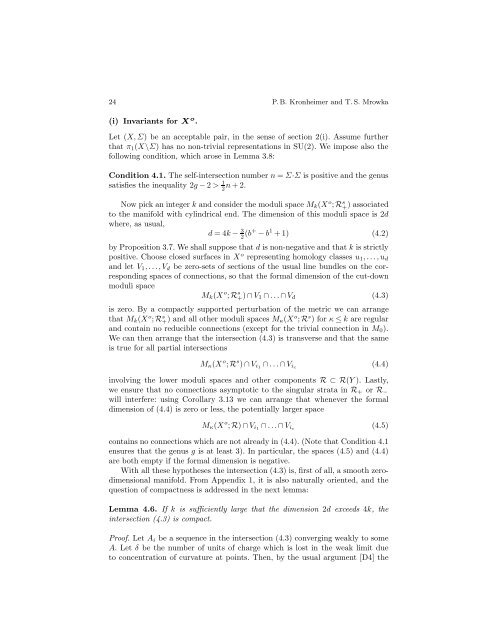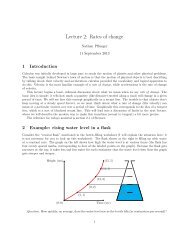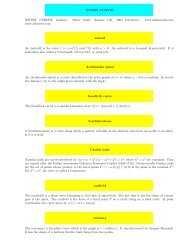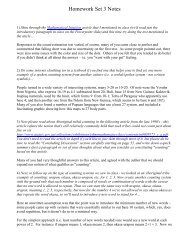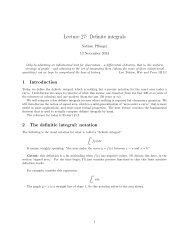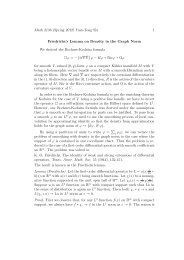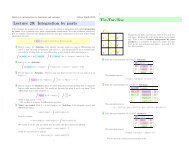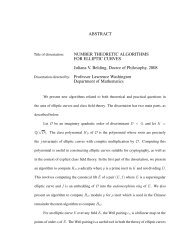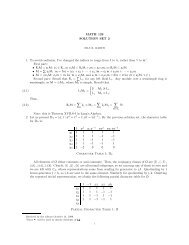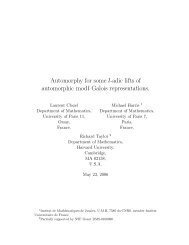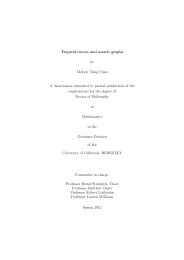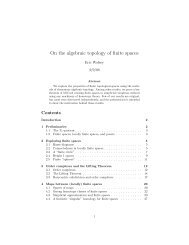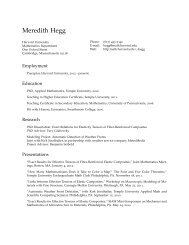Gauge theory for embedded surfaces, II
Gauge theory for embedded surfaces, II
Gauge theory for embedded surfaces, II
Create successful ePaper yourself
Turn your PDF publications into a flip-book with our unique Google optimized e-Paper software.
24 P. B. Kronheimer and T. S. Mrowka<br />
(i) Invariants <strong>for</strong> X o .<br />
Let (X,Σ) be an acceptable pair, in the sense of section 2(i). Assume further<br />
that π1(X\Σ) has no non-trivial representations in SU(2). We impose also the<br />
following condition, which arose in Lemma 3.8:<br />
Condition 4.1. The self-intersection number n = Σ·Σ is positive and the genus<br />
satisfies the inequality 2g − 2 > 1<br />
2n +2.<br />
Now pick an integer k and consider the moduli space Mk(X o ; Rs + ) associated<br />
to the manifold with cylindrical end. The dimension of this moduli space is 2d<br />
where, as usual,<br />
d =4k−3 2 (b+ −b 1 +1) (4.2)<br />
by Proposition 3.7. We shall suppose that d is non-negative and that k is strictly<br />
positive. Choose closed <strong>surfaces</strong> in X o representing homology classes u1,...,ud<br />
and let V1,...,Vd be zero-sets of sections of the usual line bundles on the corresponding<br />
spaces of connections, so that the <strong>for</strong>mal dimension of the cut-down<br />
moduli space<br />
Mk(X o ; R s +) ∩ V1 ∩ ...∩Vd<br />
(4.3)<br />
is zero. By a compactly supported perturbation of the metric we can arrange<br />
that Mk(X o ; Rs +) and all other moduli spaces Mκ(X o ; Rs )<strong>for</strong>κ≤kare regular<br />
and contain no reducible connections (except <strong>for</strong> the trivial connection in M0).<br />
We can then arrange that the intersection (4.3) is transverse and that the same<br />
is true <strong>for</strong> all partial intersections<br />
Mκ(X o ; R s ) ∩ Vi1 ∩ ...∩Vic<br />
(4.4)<br />
involving the lower moduli spaces and other components R⊂R(Y). Lastly,<br />
we ensure that no connections asymptotic to the singular strata in R+ or R−<br />
will interfere: using Corollary 3.13 we can arrange that whenever the <strong>for</strong>mal<br />
dimension of (4.4) is zero or less, the potentially larger space<br />
Mκ(X o ; R) ∩ Vi1 ∩ ...∩Vic<br />
(4.5)<br />
contains no connections which are not already in (4.4). (Note that Condition 4.1<br />
ensures that the genus g is at least 3). In particular, the spaces (4.5) and (4.4)<br />
are both empty if the <strong>for</strong>mal dimension is negative.<br />
With all these hypotheses the intersection (4.3) is, first of all, a smooth zerodimensional<br />
manifold. From Appendix 1, it is also naturally oriented, and the<br />
question of compactness is addressed in the next lemma:<br />
Lemma 4.6. If k is sufficiently large that the dimension 2d exceeds 4k, the<br />
intersection (4.3) is compact.<br />
Proof. Let Ai be a sequence in the intersection (4.3) converging weakly to some<br />
A. Let δ be the number of units of charge which is lost in the weak limit due<br />
to concentration of curvature at points. Then, by the usual argument [D4] the


